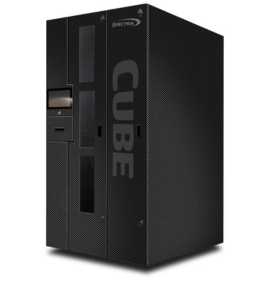Spectra Logic Ups the Ante in Tape Storage

(cybrain/Shutterstock)
Spectra Logic has been busy.
Last week, the data storage company unveiled Spectra LumOS library management software and expanded its enterprise tape storage solutions with two new additions: the TFinity Plus enterprise library and the Spectra Cube cloud-optimized library.
The Spectra Cube tape library is the company’s latest addition to its enterprise tape storage lineup. Tailored for cloud environments and emphasizing user-friendliness, the Spectra Cube library is touting swift deployment, effortless scalability, and tool-free, downtime-free maintenance.
Spectra Logic is targeting large enterprises and cloud service providers with solutions that offer improved control over data security and significant cost efficiencies. The Boulder, Colorado-based company’s latest offerings are engineered to handle the increasingly complex data landscapes faced by modern businesses.
Spectra Logic describes the Spectra Cube as being engineered for quick deployment, scalability, and maintenance without the need for tools or causing downtime. This design appeals particularly to organizations that require robust, scalable storage solutions with minimal operational impact, ensuring that business continuity is maintained even during upgrades and expansions.
The Spectra Cube offers up to 30 petabytes of native capacity, or 75 petabytes with compression, and supports up to 30 half-height or 16 full-height LTO drives, making it a versatile choice for diverse data environments. It also features an impressive speed of up to 32.4 TB per hour for native data transfers, and 81 TB per hour for compressed data, thanks to its 1,670 LTO tape cartridge slots and multiple host interface options including Fibre Channel and SAS.
The management of Spectra Cube is facilitated by the newly introduced LumOS library management software. Spectra Logic says that LumOS provides a user-friendly interface that supports both local and remote management, offering features designed to simplify the maintenance process and enhance system reliability. The software integrates with Spectra BlackPearl file and object storage systems, supporting modern backup and archive applications, including Amazon S3 and Amazon S3 Glacier API access.
![]() Additionally, Spectra Logic unveiled the TFinity Plus enterprise library, a robust solution designed for the most demanding data environments. This library can store up to 2.5 exabytes with LTO technology or 6.45 exabytes using IBM TS1170 drives, accommodating up to 56,400 tapes. It offers flexibility to mix and match various tape technologies, including LTO, IBM TS11XX, and Oracle T10000 drives, making it versatile for diverse enterprise needs. The TFinity Plus supports a throughput of up to 249.9 TB per hour natively or 544.3 TB per hour compressed, facilitating rapid access and backup capabilities
Additionally, Spectra Logic unveiled the TFinity Plus enterprise library, a robust solution designed for the most demanding data environments. This library can store up to 2.5 exabytes with LTO technology or 6.45 exabytes using IBM TS1170 drives, accommodating up to 56,400 tapes. It offers flexibility to mix and match various tape technologies, including LTO, IBM TS11XX, and Oracle T10000 drives, making it versatile for diverse enterprise needs. The TFinity Plus supports a throughput of up to 249.9 TB per hour natively or 544.3 TB per hour compressed, facilitating rapid access and backup capabilities
LumOS significantly boosts the performance capabilities of these systems. Spectra Logic describes the new library management software as the “next generation operating system for managing, monitoring and controlling Spectra tape libraries.” It lets admins monitor and manage TFinity Plus and Spectra Cube libraries either locally or remotely, with 20x the performance, the company claims.
LumOS supports multi-threaded operations and offers a full REST API for comprehensive automation of all library functions. Noteworthy features include integrated partitioning for shared environments, automatic drive cleaning, dynamic media slot additions, and AES-256 encryption for enhanced data security.
At the moment, Spectra Logic is capping off its promotional marathon by showcasing the Spectra Cube to interested attendees of the NAB Show at the Las Vegas Convention Center, Booth SL3099.
Here’s hoping the tape library powerhouse stays busy.
Related Items
IBM Reveals New Diamondback Tape Library Archival Storage
Spectra Logic Extends Storage Scalability Leadership with New IBM TS1170 Drives
Academia, Biosciences, Energy, Financial Services, Government, Healthcare, Manufacturing, Other, Retail, Science, Telecommunications
LumOS, Spectra Cube, spectra logic, Spectra TFinity ExaScale Tape Library, tape, tape archives, tape libraries, tape library, tape storage, TFinity, TFinity Plus


